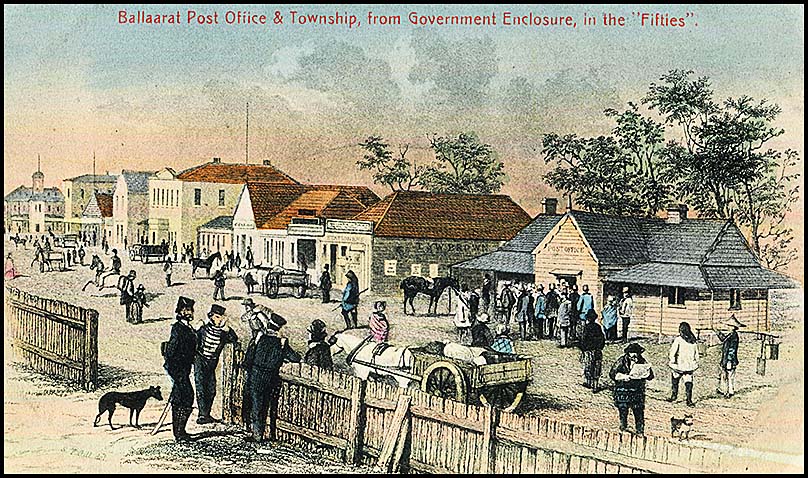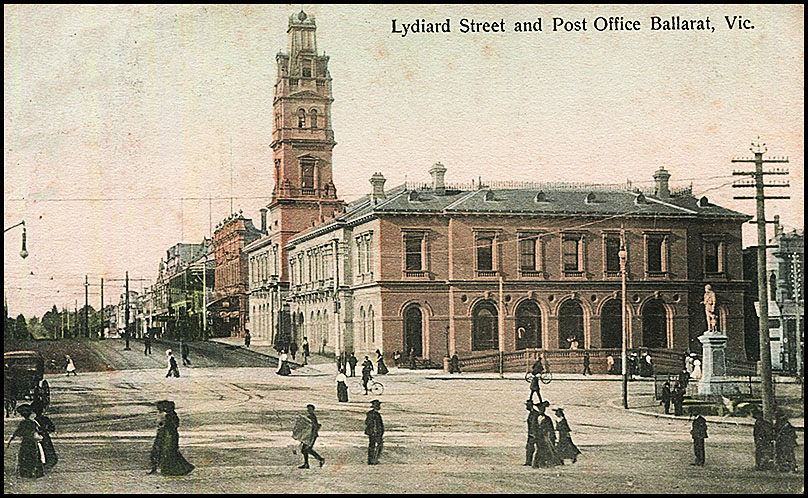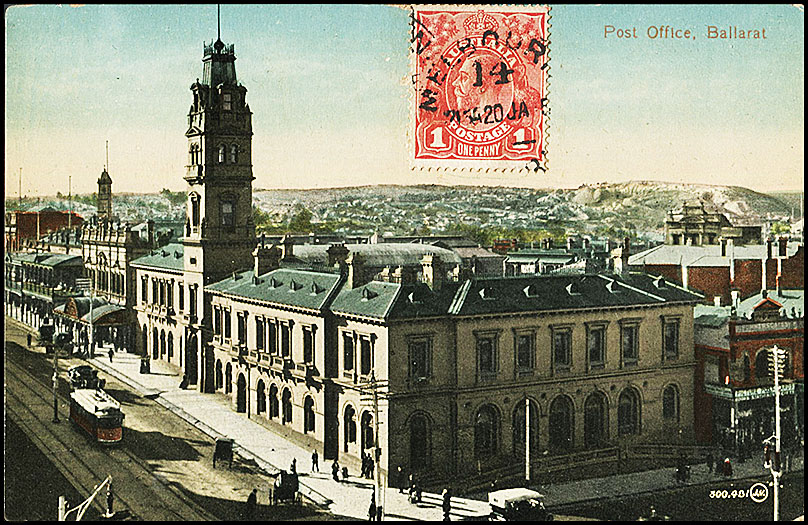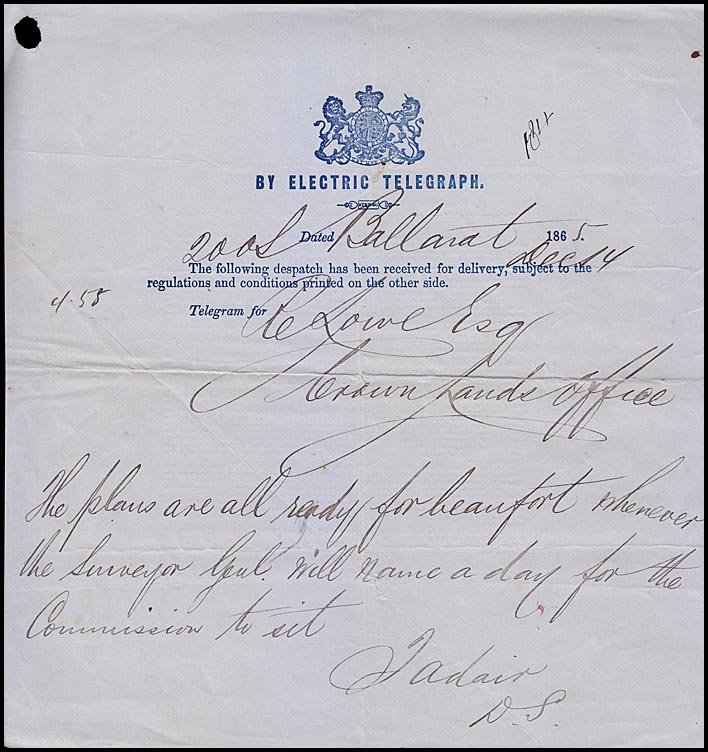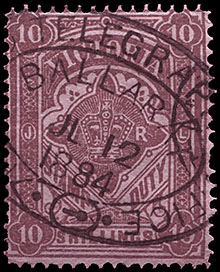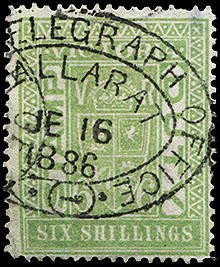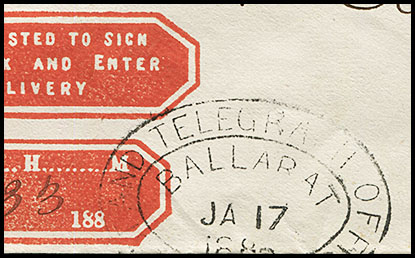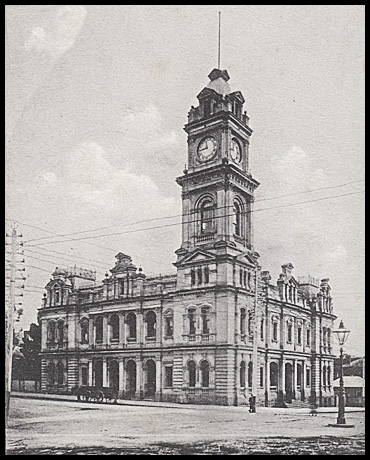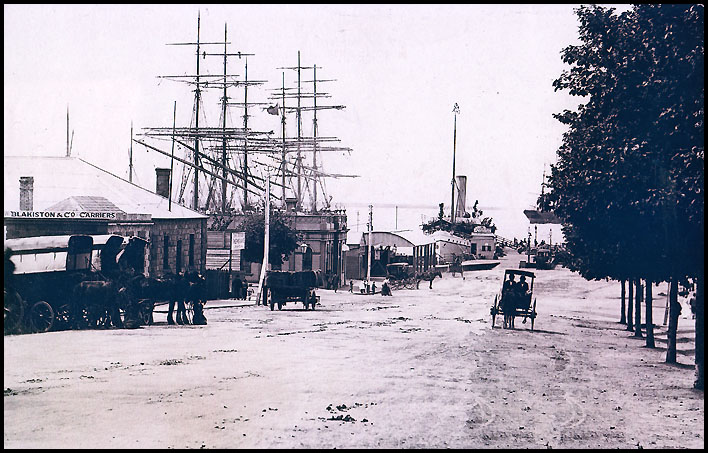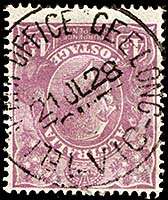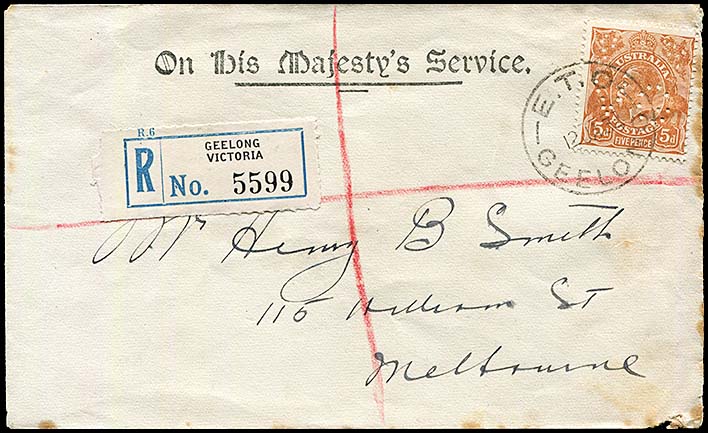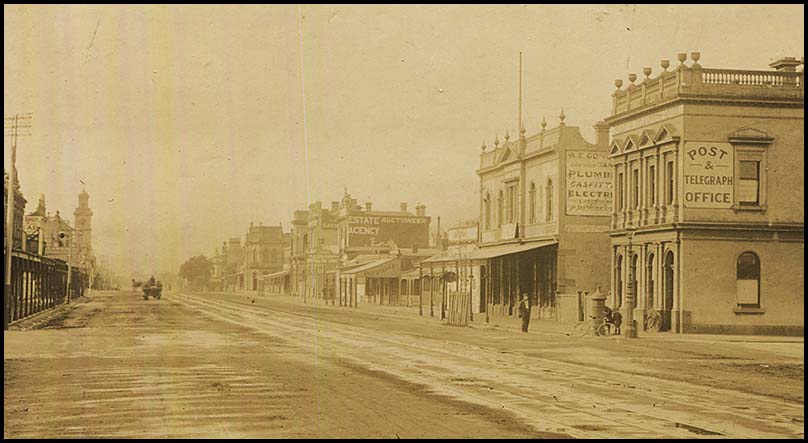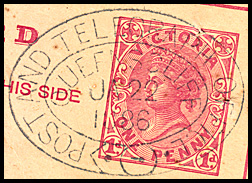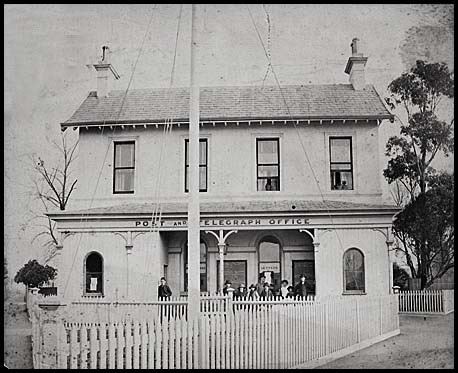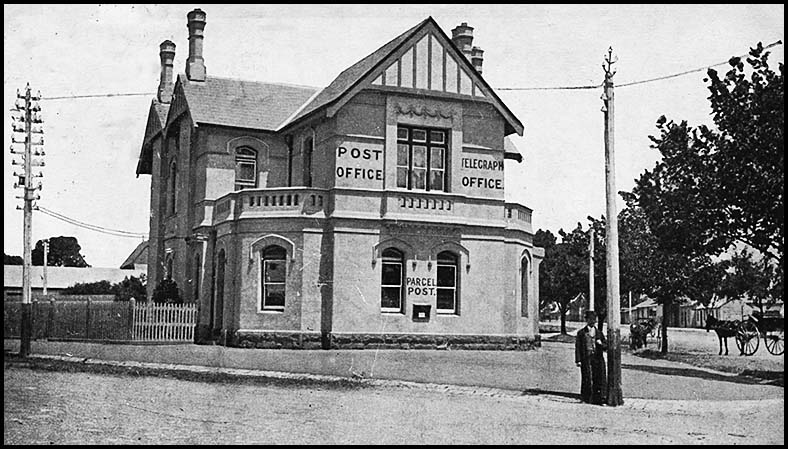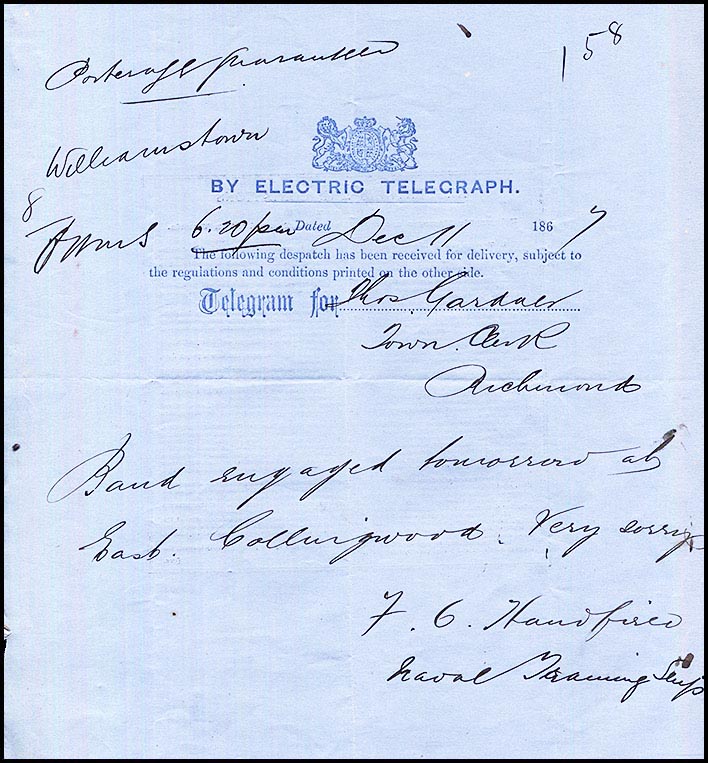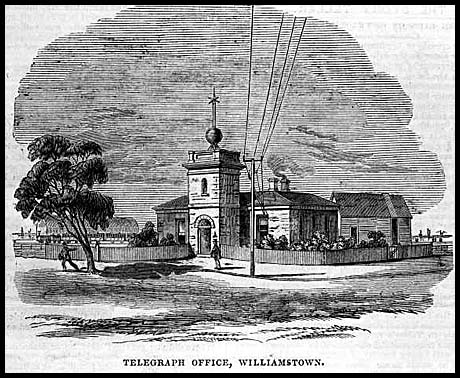Telegraph Offices on the first lines - 1854 to 1856.
- Australia 1901-1988
- New South Wales
- Queensland
- South Australia
- Tasmania
- Victoria
- Western Australia
- International
- Special aspects
The Telegraph Offices on the first line which are described here are:
| Ballarat | Bendigo (Sandhurst) | Geelong | Gisborne | Kyneton |
| Port Melbourne (Sandridge) | Queenscliff | Williamstown. |
1. Background. The Telegraph Office opened on 15 December 1856 for public purposes. The Office was in a temporary locattion on Camp Hill near the Local Court. The Star reported an unfortunate circumstance on 16 December 1856: "The line would have been opened a day or two ago had it not been delayed by some scoundrels breaking the wire between Meredith and the Burnt Bridge. Mr McGowan went off yesterday morning and succeeded in repairing it so that messages could be transmitted in the afternoon. The practice of breaking the wire is becoming quite a common one with bullock drivers, who drive their drays against the posts and, by the concussion, often succeed in snapping the wire and sometimes break the post on a level with the ground. It is high time that such a reprehensible practice should be put a stop to and we hope all travellers who may be witnesses to any such acts of vandalism will at once take the perpetrators in charge and hand them over to the tender mercies of the police". |
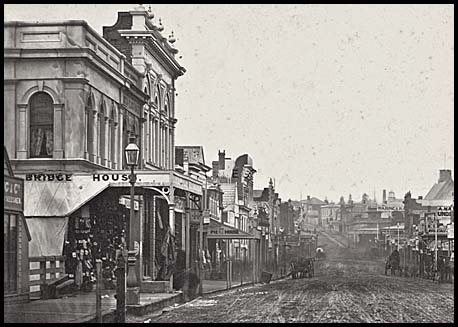 Bridge Street, Ballarat in the late 1860s. |
|
The results of the races just before Christmas 1856 were telegraphed to Geelong for publication "as soon as they were known at Ballaarat". Very important and the sign of a good working system!! On 8 November 1856, the Ballarat Star had published the tender details as follows:
The Age of 12 November 1856 repeated the above story from the Ballarat Star: and added "We understand that the station will be built on the corner of the camp, opposite the Bank of Australasia, and that we may expect the line to be completed by the middle of next month. We cannot but approve of the choice of the site selected for the station". The Gazette of 5 December 1856 listed acceptance of the tender from Campbell and Thompson for the erection of a Telegraph office at Ballarat for the sum of £1,300. On 1 January 1858, the population of Ballarat was 120,321. In the three months to July 1858, 1,300,000 ounces of gold were produced around Ballarat. See other interesting facts about Ballarat at that time. |
||
|
||
On 14 April 1879, the Ballarat Courier reported: "In compliance with a resolution passed at the last meeting of the Town Council, urging upon the Postmaster-General the claims of the town to a Post and Telegraph and Money Order office, Mr. James, M.L.A., waited on Mr Patterson on Thursday last and, as the question of site is unsettled, that gentleman promised to come to Ballarat and see the various positions under consideration as soon after the Easter holidays as convenient". On 7th December 1880, the Ballarat Courier wrote an editorial (p. 2) about improving the City especially the Lydiard Street frontages in the heart of the city. As a start, they suggested "The old telegraph office and the Registrar's office should be pulled down and the police barracks removed down to Camp Street ... It is an annoyance to every resident of the town to see this piece of land abused as it is; and any attempt made by the Government to sweep away this vexation would have the sympathy of every resident of the city". The Ballarat Courier of 6 April 1881 (p. 2) reported on a possible major development. The Bendigo Stock Exchange was preparing to send a deputation to the Postmaster-General "asking that gentleman to lay on a wire from the main local telegraph office into the very heart of the sharemarket". The Ballarat Stock Exchange agreed with the concept and therefore wished to have a similar installation in their Stock Exchange. It is not known to what extent the deputations were successful.
On 22 September 1858, The Star reported that "Mr Bechervaise, the telegraph station master in Ballarat, informs us that he has now received the instruments for the working of the second wire between this and Geelong, and that the two wires are now working well". In 1871, a new Post and Telegraph Office was occupied. On 7th December 1880, The Ballarat Courier wrote an editorial (p. 2) about improving the City especially the Lydiard Street frontages in the heart of the city. As a start, they suggest "The old telegraph office and the Registrar's office should be pulled down and the police barracks removed down to Camp Street ... It is an annoyance to every resident of the town to see this piece of land abused as it is; and any attempt made by the Government to sweep away this vexation would have the sympathy of every resident of the city". The Ballarat Courier of 6 April 1881 (p. 2) reported on a possible major development. The Bendigo Stock Exchange was preparing to send a deputation to the Postmaster-General "asking that gentleman to lay on a wire from the main local telegraph office into the very heart of the sharemarket". The Ballarat Stock Exchange agreed with the concept and therefore wished to have a similar installation in their Stock Exchange. It is not known to what extent the deputations were successful. |
||
|
||
|
As early as January 1857, the Telegraph Office was being used extensively. On 28 January 1857, in the Legislative Assembly, the staffing at the office was questioned. Mr. Humffray asked the Commissioner of Trade and Customs whether it was the intention of the Government to appoint an assistant to Mr Baker in the telegraph office at Ballaarat. Mr. Childers replied that provisions had been made on the estimates for a head master, a line master and a messenger and, until it was known what the business would probably be, the Government were not inclined to augment that staff. Mr. Humffray then stated Mr Baker was engaged from an early hour in the morning to a very late hour at night. Mr Childers observed that every master of a telegraph station was in a similar position. The Portland Guardian of 8 May 1861 reported that "Bartholomew Guyot, a late Clerk in the Telegraph Office, was committed for trial at the Ballarat Sessions on the charge of having embezzeled £42 of the Government's money". On 5 June 1874, the Ballarat Courier noted the following: "It has already been made public that Mr C. G. Badge, the Inspector of Victorian railway telegraphs, has for the past six months been incapacitated from his professional duties by an attack of dreadful illness and a consequent loss of eyesight. The afflicted gentleman has applied to the department for an extended leave of absence and his request has been forwarded to the Cabinet. Mr. Badge was one of the first operators here in 1859 when there were only three or four lines of telegraph throughout the colony. His long services since that time, and his present calamity, give him an especial claim to consideration". |
||
Mr. Bechervaise. In February 1858, Mr. William P. Bechervaise was appointed as Station Master of the new Ballarat Telegraph Station. On 10 July 1858, the first telegraphic message was sent from Ballarat to Sydney. In the Legislative Assembly on 14 February 1862, an amount of £42 16s. 11d was allocated for payment to W. O. Bechervaise, telegraph manager at Ballarat as a reimbursement of the amount embezzled by B. A. P. Guyot who had been convicted of the offence. Yet more trials were to be faced by Mr. Bechervaise. The Ballarat Star of 6 March 1862 reported a storm which had hit the Ballarat district: "The hot weather which we have had so long culminated in a thunder storm yesterday evening. During the day the weather had been extremely close and, shortly after sunset, vivid flashes of lightning were seen towards the north which gradually approached nearer and grew more dazzling. About half-past ten o'clock rain fell heavily - greatly to the delight of all who had felt the inconveniences of our short water supply and the peals of thunder were very loud and long-continued. The storm, however, did not last more than half an hour and the quantity of water that has fallen will do but little to supply our wants. During the storm, the Telegraph Office was set on fire by the lightning and it was only saved from destruction by the exertions of the Station Master assisted by several other persons. It appears that shortly before eleven o'clock, whilst Mr Bechervaise was sitting in his private room, he heard repeated electric sparks flashing from the wires but did not deem it advisable to enter the office. He was suddenly alarmed by a loud knocking at the door and, on rushing outside, he found that the lightning had run along the wire and set the window frame, curtains, rollers, etc. in flames. With the assistance of Detective Sincock, Mr Forster, Mr Croak and several other persons who had observed the fire, the flames were extinguished but not before a good deal of damage had been done. It was found however that the lightning kept running along the wires and re-igniting the charred window frames so that it was found necessary to cut away all the wires and lightning arresters from the office in order to save it from being burned down. Communication with other places is therefore cut off for the present but every exertion is being used to re-open it and it is expected that the wires will be once more in working order by noon, or shortly after, this day". After 22 years, Mr Bechervaise at last had a change of scenery. The Ballarat Courier of 13 January 1879 reported: "Mr Bechervaise will leave Ballarat to-day to commence work in his new sphere at the Telegraph Office, Melbourne. We avail ourselves of this event to publicly record the courteous manner in which he has always acted to the public during is long connection with Ballarat, and to acknowledge the efficient manner in which he has generally discharged his duties. Mr Bechervaise will henceforth be stationed in Melbourne, where he will have full charge of the Telegraph Office". On 26 February 1879, the Geelong Advertiser notedIt is only fair to point out that this story was followed by some recommendations to the Ballarat Inspector of Nuisances. that the PR Machine continued to roll on: "We are pleased to notice that Mr W. P. Bechervaise, the manager pro-tem of the Electric Telegraph Department, Melbourne was the recipient yesterday of a valuable watch, subscribed by the public of Ballarat, where Mr Bechervaise was for many years Post and Telegraph Master. From our own knowledge, and by general testimony, Mr Bechervaise is one of the most able and efficient officers of his department, his appointment to the charge of the Melbourne office testifying to the official confidence reposed in him". On 28 January 1880, The Age noted: "The appointment of Mr. Bechervaise to the management of the Electric Telegraph Office in Melbourne and the removal of Mr. James to Ballarat was the subject of some adverse criticism in the Assembly last evening, which called for a reply from the Postmaster-General. He explained that the reasons which led to the exchange of positions between the telegraph managers at Ballarat and Melbourne respectively were strictly of a departmental character and with the special view of increasing the efficiency of the service, securing a more strict discipline in the large staff of operators employed in Melbourne. The neccessity for some change of the kind had long been apparent and when the two officers referred to became of equal rank (viz. second class), a transfer became practicable without inflicting pecuniary loss on one or the other. Mr. James still is in receipt of £100 per year more than Mr. Bechervaise. The change, however, Mr. Patterson explained, was not one of a permanent character". See also references to Mr. Bechervaise in regard to house-moving and at the races. HOWEVER - according to the report in the Camperdown Chronicle of 22 April 1879 and other sources: "Last week Mr. Harte, who used to be in the Ballarat Post Office, was presented by his old colleagues here with a gold medal and chain. He is now in the Melbourne office. And so is Bechervaise, that is next doer, in the Telegraph Department. They both hated each other with a nearly perfect hatred, they both left Ballarat at the same time and, as they were lovely in their Ballarat life, so in Melbourne they are scarce divided How true it is that Providence tempers the wind to the shorn lambs of humanity". |
||
|
On 10 July 1858, the first telegraphic message was sent from Ballarat to Sydney. The earliest indication of the operation of the Ballarat Telegraph Office is a telegram delivery form issued at Ballarat on 14 December 1865. |
||
|
||
|
There were thee main types of date stamp used at Ballarat for telegraphic purposes:
|
||
4.1: Belt and Buckle date stamps. Ballarat had two formats for its Belt & Buckle date stamps:
|
Provenance:
|
Provenance: Hugh Freeman, Johnstone. |
|
||
|
|
|
| 4.2: Steel TELEGRAPH OFFICE date stamps.
At least four (and possibly five) designs for a TELEGRAPH OFFICE date stamp were used between 1905 and 1982. They can be easily distinguished from the wording at the top and the diameter. |
||
|
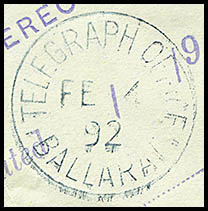
4 February 1892. Used on VC-DO-13. |
|
|
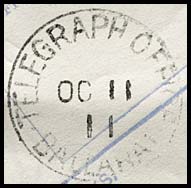 11 October 1911. Used on VI-DO-3Da. |
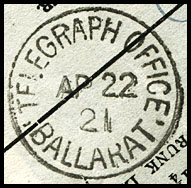 22 April 1921. Used on a Telephone account. |
 10 August 1926. On a pair of £2 purple-black & rose 3rd watermark Kangaroo on map. |
||
|
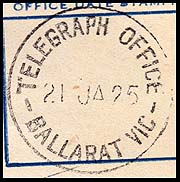 21 January 1925. Used on AB-DO-3Ba. |
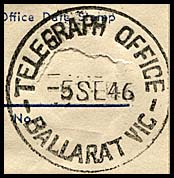 5 September 1946. Used on AW-DO-10Aa (44). |
|
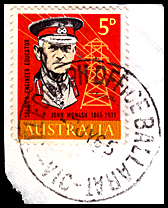 9 July 1965. |
|
| 4.3: A steel T.O. date stamp. | ||
|
||
|
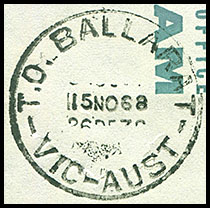 15 November 1968. (earliest recorded date) . |
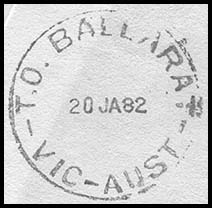 20 January 1982. |
The only postal slogan advertising telegraphs used at Bendigo was HAPPY THOUGHTS CHRISTMAS AND NEW YEAR GREETINGS BY TELEGRAM. |
|
| Datestamp: Circle (diameter: 22 mm).
Base inscription: VIC. AUST. Characteristics: Earliest recorded date of this format: Latest recorded date of this format: Number in the Census: 5. |
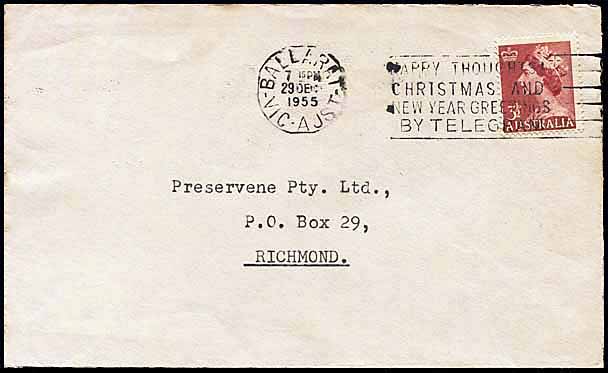 |
|
In August 1870 there was a major break-out from the gaol. The Ballarat Star claimed "that the cost to the state of the late Ballarat Gaol breaking has been not less than £2,000. Of this amount, it has been estimated that £500 worth of telegraphing was done in connection with the affair". |
|
There was a Telegraph Office at the Ballarat Race Course at some time - open only on race days. Certainly there was a telegraph line from Ballarat to the course to transmit and receive telegrams for the Ballarat Spring Carnival held in early December 1871. The Ballarat Star of 4 December 1873 reported "The Electric Telegraph Office at the Ballarat racecourse will be opened to-day and to-morrow at 12 noon and will be closed each day 30 minutes after the running of the last race. There will be no delivery on the course but a list of telegrams received at the race course office will be posted outside". The Argus of 24 March 1876 reported: "The opening meeting of the newly-formed Victoria Amateur Turf Club takes place today on the Ballarat course. There are six events, of which the principal is the Victoria Gold Cup Handicap Steeplechase of three miles ... There will be one train soon after noon from Ballarat West to the course and one back after the last race. The telegraph office will be open on the course during the day". Nothing else is known about this Office. It may be a precursor of the T.O. opened at the Ballarat Miners' Racecourse between about 1933 and 1938. |
|
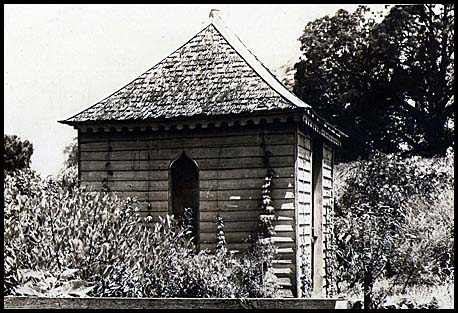 The first Telegraph Office in Geelong - the temporary office. Pre-fabricated in Sydney and re-erected in Geelong in 1838. Originally had a thatch roof but that was replaced in 1854 with shingles. In 1857 when the new Telegraph Office was constructed, this structure was used as the Customs House. |
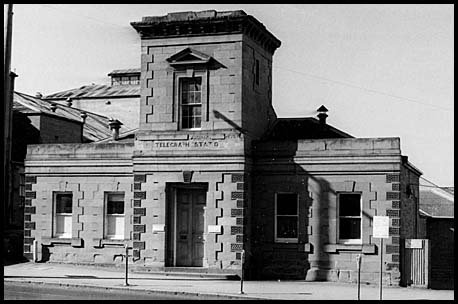 The Old Telegraph Station at 83 Ryrie Street - as from July 1857. (Photographer: John Collins). Source: State Library of Victoria SLV H96 210449. |
The Argus, of 24 January 1855 (p.4) ran the following story from the Geelong Correspondent: "As the grand principle of the electric telegraph is rapidity of communication, I am at a loss to understand why the Geelong Telegraph Office has been placed beyond the pale of business entirely. Had some fool or evil-disposed person wished to ridicule the affair, or deprive the public of the vast benefits to be derived from the establishment, he could have taken no better step than the Government has done itself by placing the office outside the town, that is, at the corner of Bellerine and McKillop streets, about one mile from the centre of business. Just fancy the Melbourne office being erected at Collingwood and you will have some idea of the inconvenience we shall be afforded, from what you might expect yourselves in that case. The public should endeavor to have this ridiculous arrangement altered at once". The story is continued at length elsewhere. The same theme of the Telegraph Office being misplaced was repeated in other articles - see here for a 2 June 1855 example. The debate continued (pity to the people of Geelong) as shown by the following from The Star of 14 October 1856: "Among the topics discussed by commercial men during the past fortnight, that of the contemplated removal of the Electric Telegraph Office seems to have excited most general interest. In Monday's paper, reference was made to the reported selection of the old Custom House for this purpose but there are several grave objections against this course. The accommodation there is very scant. The one room above is not of large dimensions and the cellars below would be occupied by the batteries required to produce the electric current. There would therefore be no adequate means of securing that secrecy which is an essential element in this department of the public service; nor room for the additional instruments and extra staff that will be necessary when the lines now in progress to Ballarat and Castlemaine have been completed. Besides, unless the station master resides at his offices, the advantages resulting from instantaneous communication between distant localities are limited to the hours of routine duty instead of extending over both day and night. Matters of life and death that might be transmitted from one end of the colony to another in a second of time might be thus delayed for many hours and cause incalculable loss. On the score of distance from the business portion of the place and the facilities of approach, the change would be attended with but little benefit to the public at large; the town is evidently moving westward, and when another spot is fixed upon and the expenses of alteration incurred, it would be far better that a permanent site should be chosen at once. Something has been said about a branch office but owing to the peculiar action of the electric current, such an arrangement as that would, in many instances, entirely prevent some stations from corresponding with others. The work of the telegraph is felt to be important now but the time is near at hand when it will become still more so. New South Wales and South Australia are bent on opening up a communication with this colony by means of this wonderful invention. Tasmania is taking active measures to effect the same end. The establishment here must before long be on a far larger scale than at present. We would therefore suggest the advisability of erecting in the centre of the town, a building suitable to the present requirements of the office with space for any additions which will subsequently be wanted. If the Corporation would give a portion of the Market Square for this purpose, it would be worthily appropriated; but, if not, there is an eligible site in Moorabool Street near Corio Street which is as yet unsold and would suit this purpose well". On 28 January 1857, in the Legislative Assembly, Mr. Childers, in reply to Mr. Fyfe, said it was the intention of the Government to change the site of the present telegraph station at Geelong but the new site had not been determined. He imagined, however, that it would be erected somewhere in the vicinity of the Post Office of that town. The Gazette of 8 April 1861 announced the appointment of David Russell Penton as manager of the Telegraph Office at Geelong from 25 March, 1861. In the Legislative Assembly of 6th July 1865, "Mr. Foott moved that the House would, tomorrow, resolve itself into a committee of the whole, to consider the propriety of presenting an address to his Excellency the Governor, praying him to cause a sum equal to a year's salary to be placed on an additional estimate for 1865, as a gratuity to the widow of the late Mr. Penton, late Telegraph Master at Geelong. Mr. Edwards seconded the motion, which was negatived". The Geelong Advertiser of 6 February 1874 reported on the farwell dinner at the Terminus Hotel prepared for Mr. Thomas Wright who had been connected with the Geelong Telegraph Office for a number of years. He was described as "an unassuming and obliging official, and a gentleman in the best sense of the word. Geelong could ill afford to lose such men as he, still it was matter for congratulation that his removal to Melbourne would be for his pecuniary benefit, and an advancement in the service. Mr Wright, who has been in Geelong since his birth, feelingly replied, a number of other toasts were given, and altogether a very pleasant evening was passed". In February 1881, an advertisement for the auction of a property described the lot, in part, as being "a residence in McKillop Street, next door to the old telegraph office". On 28 September 1880, the Geelong Times reported the following: "Mr. Vivian, the Geelong Postmaster and Telegraph Manager, has received notice that the Government intends to dispense with his services. Mr. Vivian has been 16 years in Geelong, having come to Geelong from Queenscliff to fill the place of Mr. Thacker, who was promoted to Ballarat. He was an efficient officer but for years he has been in failing health. His salary was £450 per annum and the Government, it is surmised, intend to save all this sum, except the pension, by uniting Mr. Vivian's duties with those of some other officers in the department". The Geelong Advertiser of 1 April 1882 reported a glowing account of the improvements to the Telegraph Office: "Very substantial improvements have been recently made, at the instance of the local Postmaster, Mr. Fisher, to the Telegraphic Office. The place is now well sheltered from the wind and dust by folding doors near the main entrance from Ryrie Street. The room where telegraphic communications may be written by the public is furnished with a table, several chairs and two desks and the writing materials are kept free from dirt, an admirable state of things as compared with the old system. The receiving window has been placed in a more conspicuous position and, instead of being a narrow pigeon hole affair which formerly necessitated the passing of a telegram sideways through a dark passage, the officer in charge may be seen and spoken to. The whole place has been cleaned and painted, both inside and outside and every attention paid to the comfort of the telegraph operators. The shipping boards outside of the telegraph office have been replaced by decent looking articles and the walls of the Post Office front have been cleansed and painted, whilst the letter and newspaper boxes are so constructed that the addresses on the missives and papers cannot be read by persons loitering in the lobby. The only thing left to be done is to prevent young men and boys from making the Post Office lobby a resort for larrikinism at night". In October 1887, questions were asked in the Legislative Assembly as to why telegrams delivered near Geelong attracted a 3/- charge. The Geelong Advertiser of 3 October 1889 reported that "It was mentioned during the proceedings in the Local Option Court of Arbitration yesterday, that Mr L Ryan of the Union Club Hotel purchased the old Post and Telegraph Office buildings in Ryrie and Gheringhap Streets for £270. The buildings have to be pulled down and carted away by the purchaser. Yesterday Mr Ryan sold by auction a portion of the structure he purchased for the sum of £90". |
|
| Seven formats for date stamps were used at Geelong: | |
The first two formats were 1-hole and 2-hole BELT & BUCKLE date stamps - although the 1-hole format is a very recent discovery.
|
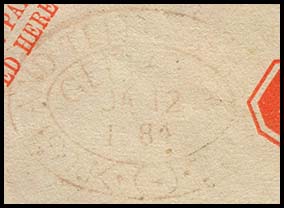 12 January 1884. Used on VC-EO-8. |
|
Characteristics:
|
|
|
Characteristics:
|
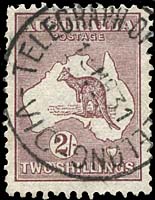 13 March 1931. |
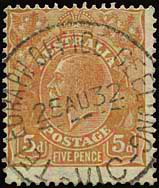 25 August 1932. |
 11 May 1940. Used on Mothers' Day form (AA-GM-39). |
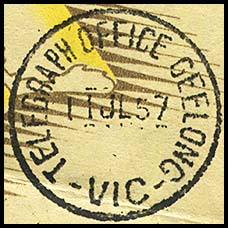 11 July 1957. |
Characteristics:
|
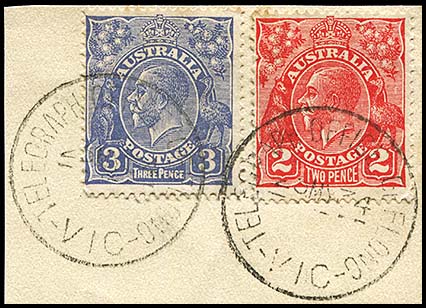 23 May 1934. |
|
| This date stamp was also used in violet at the Fire Demonstration in March 1940. | 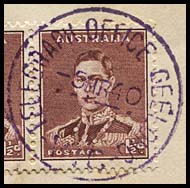 Detail from cover below. 5 March 1940. |
||
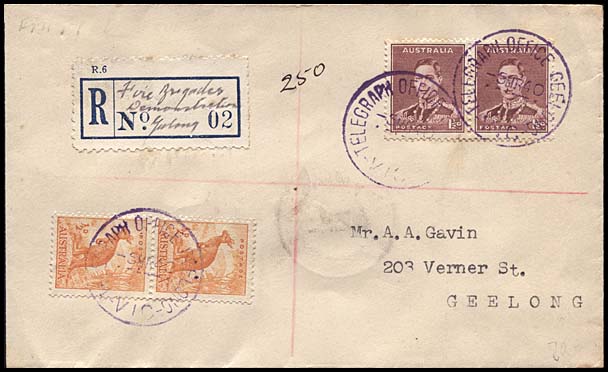 |
|||
Characteristics:
|
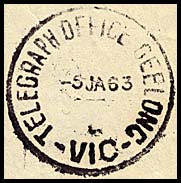 5 January 1963. (ERD - see Geelong). (see APO form AA-DO-13D). |
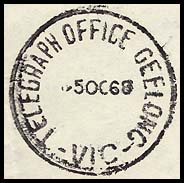 5 October 1968. |
Characteristics:
|
|
|
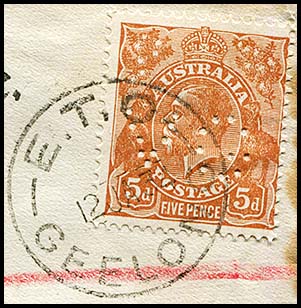 Detail of the above cover. |
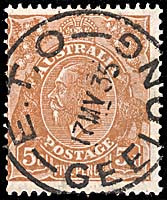 17 May 1935. |
|
| Postal date stamps used on telegrams: | 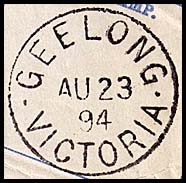 Geelong 23 August 1894. Used on telegram type VC-DO-15B. Diameter: 26 mm. |
|
Only two postal slogans advertising telegraphs were used at Geelong::
|
|||
HAPPY THOUGHTS! CHRISTMAS AND NEW YEAR GREETINGS BY TELEGRAM. Datestamp: Circle (diameter: 22 mm). Base inscription: VIC. AUST. Characteristics: Only recorded date of this format: Number in the Census: 2. |
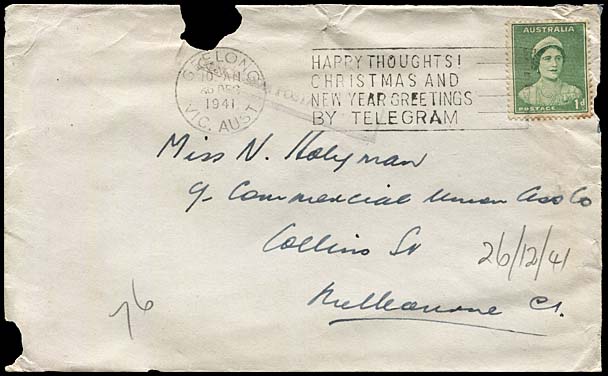 26 December 1941. |
||
SEND A TELEGRAM Date stamp: Circular (diameter 22 mm) Base inscription: VIC. AUST. Characteristics: Die 4A: A over G. Earliest date recorded: Latest date recorded: Number in Census: 2. |
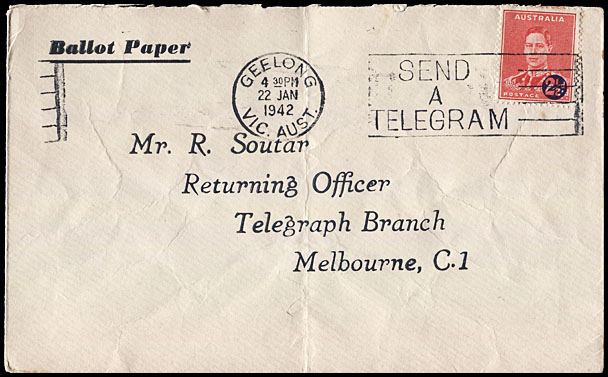 22 January 1942. |
||
Telegraph Offices were also opened at four locations around Geelong: |
||
The Telegraph Office at the ground opened about 1933 and it closed about 1940.
|
|
|
|
The Telegraph Office at the factory opened about 1926 and closed on 14 September 1956. The date stamp GEELONG FORD'S Works is known for:
|
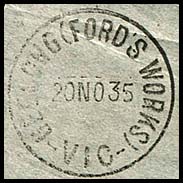 20 November 1935. |
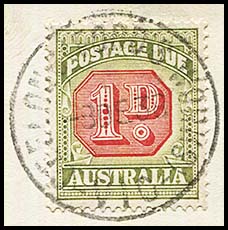 8 December 1938. Used on a 1d Postage Due. |
The Telegraph Office at the Station opened about 1910 and was reclassified as a PO about 1915. It was then reclassified back to a Telegraph Office about 1940 before closing on 20 August 1976. No information about a date stamp is available. |
||
|
On 26 January 1874, the Geelong Advertiser reported that "A letter has been received from the Deputy Postmaster-General, stating the application made by the secretary of tbe Geelong Racing Club that telegraph communication be extended to the course, will receive the attention of the hon. the Minister iu whose department the management of the telegraph is vested". A telegraph connection was opened to the Geelong Race Course on 1st or 2nd February 1879: "This is a boon which will be appreciated by thousands of persons who take an interest in the events run for on the Geelong course. It is expected that the line will be ready for use on the 1st and 2nd February, the days of the annual race gathering of the local club" That Telegraph Office at the Racecourse must have closed at some time for it is recorded as reopening about 1933 then closing about 1940. No information about a date stamp is available. |
||
| Port Melbourne (Sandridge).
The Telegraph Office opened as Sandridge in July 1855 as part of the first telegraph line in Victoria. On 1 February 1861, Henry Salkeld was appointed Manager of the Telegraph Office at Sandridge replacing Edmund Banks who had been transferred to the new office at Carisbrook. On 1 October, Henry transferred to Yakandandah. The Gazette of 21 April 1863 noted "John Duigan to be Manager of Electric Telegraph and Collector of Imposts, also to act as Postmaster at Sandridge from 1st April, 1863 vice Alfred Croft transferred (to Benalla)". In 1884, the original name of Sandridge was changed to Port Melbourne. |
||
|
||
| Two date stamps were issued to Port Melbourne Telegraph Office for use with telegraphic business: | ||
|
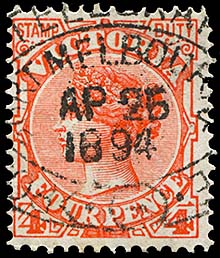 25 April 1894. (Latest recorded date). |
|
|
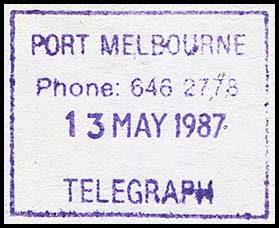 13 May 1987. |
|
| The usual postal date stamp was also used on telegrams: | 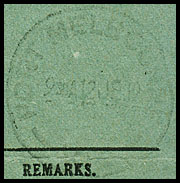 12 June 1919. Faint postal date stamp on |
|
| Queenscliff.
The Telegraph Office opened in January 1855. By mid-September 1854, the foundation work for the Electric Telegraph Office had been commenced. It was constructed by Mr. G. W. Owen who later also constructed the Camberwell-Lilydale telegraph line and (later still) ran for the Council in Traralgon in 1900. The Post Office had opened as Shortland's Bluff on 1 May 1853 but changed name to Queenscliff in 1854. |
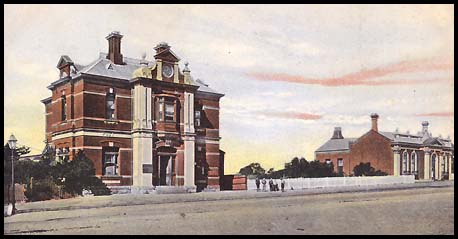 The Queenscliff(e) Post Office (left) and Free Library. |
It did not take long to capitalise on the presence of the Telegraph Office. From January 1855, the Argus was carrying advertisements similar to the following: In August 1872, a Sperm Whale was discovered just off Queenscliff by Mr. Barbour - the then Telegraph Master. He enlisted the assistance of the Health Officer who used his boat to tow "the prize" into shallow water. The Geelong Advertiser estimated the value of the oil likely to be obtained from the blubber would be more than £500.There is no report as to how that amount would be shared. |
|
| A 1 hole Belt & Buckle date stamp was issued to Queenscliff.
Used in black: 22 January 1886 and 6 April 1894. Size: 27 × 38 mm (e = 0.70). Rated: not scarce. |
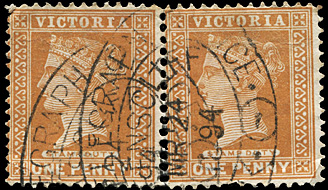 24 March 1894. |
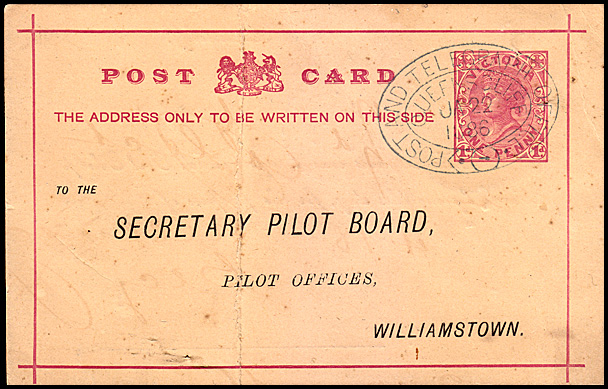 |
Used on a postcard to the Pilot Board reporting "the Mavis had been brought inside Port Philip Heads by me this day for the purpose of getting provisions". |
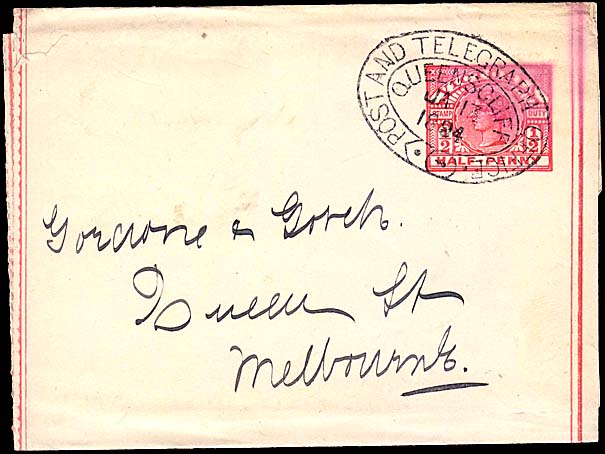 |
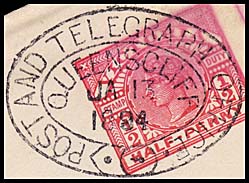 13 January 1894. Used on a wrapper to Gordon & Gotch. |
|
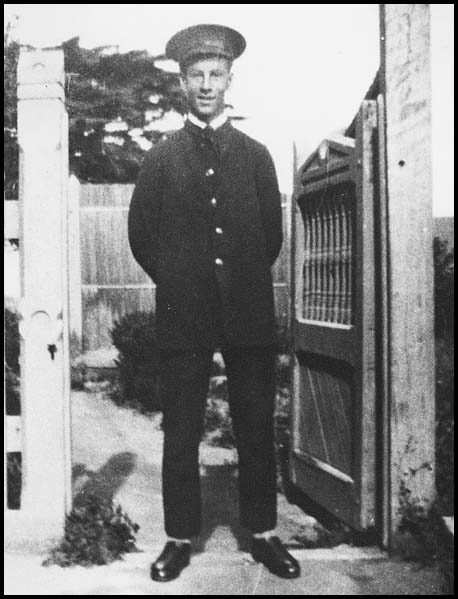 Source: State Library of Victoria H2010 120/1. |
In 1923, Bob Kent was a Telegraph Messenger employed by the PMG Department.
Bob was assigned to the Queenscliff Telegraph Office. At that time, Bob was aged 14 years. |
The TELEGRAPH OFFICE.
|
| Early forms. |
| The earliest indication of the operation of the Williamstown Telegraph Office is a message on a telegram delivery form (VC-DO-4A) received at Richmond on 11 December 1867 from Williamstown. |
|
Date stamps. Two types of date stamps were issued explicitly for use with telegraphic work:
In addition, the usual postal date stamp was also used. |
1 hole Belt & Buckle date stamps were used at Williamstown:
|
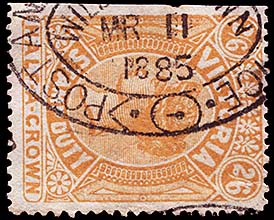 Used 11 March 1885. Provenance: Hugh Freeman, James Johnstone. |
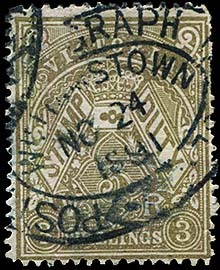 24 November 1891. Provenance: Hugh Freeman, James Johnstone. |
|
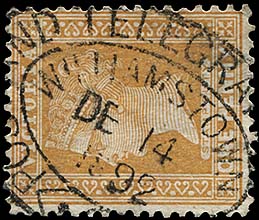 14 December 1892. |
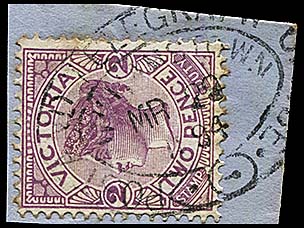 29 March 1894. |
| 21 March 1889. Belt & Buckle 1 hole date stamp used in black on the postcard to The Advertiser shown below and the reverse side to the right. |
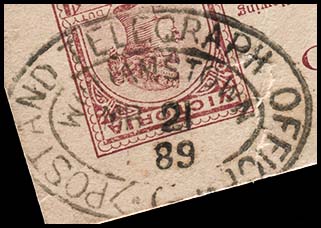 Detail of the Belt& Buckle date stamp. |
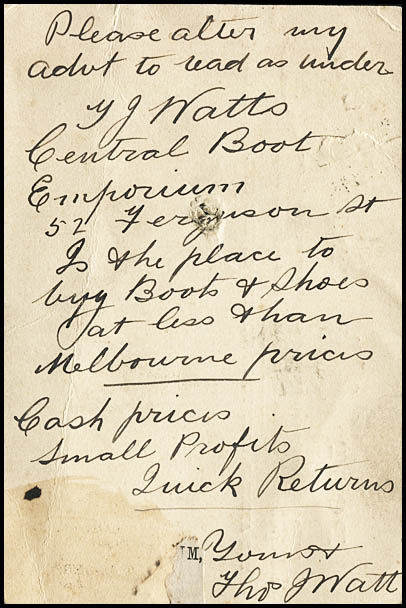 Reverse side of the postcard to the Advertiser. |
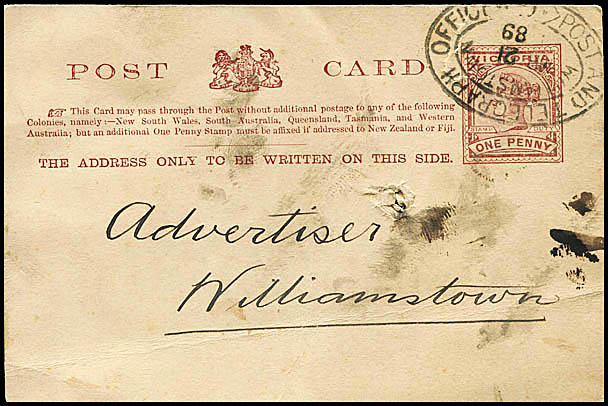 21 March 1889 Belt & Buckle date stamp on a postcard. |
||
A rubber TELEGRAPH date stamp (RRV1-T) was also used at the Telegraph Office.
|
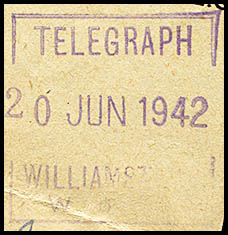 20 June 1942. Used on AB-GCF-39C. |
| Ordinary postal date stamps were also used on telegrams and delivery envelopes - especially after 12 June 1879 when the Post and Telegraphs Department issued an official instruction that all telegrams for delivery should be marked with a date stamp of the receiving office..
|
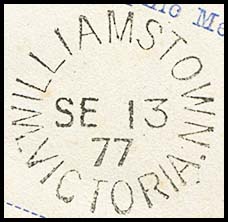 Williamstown unframed date stamp. 13 September 1877. Used on VC-DO-8B. Earliest recorded use of a date stamp on a Victorian telegram delivery form. |
